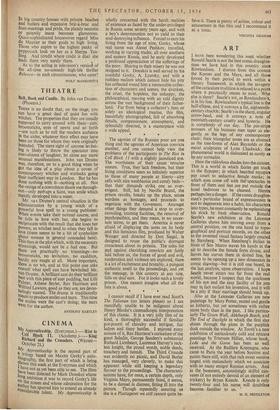ART
I HAVE been wondering this week whether Ronald Searle is not the best comic draughts- man we have had in this country since Rowlandson. I dismiss from this context the Keenes and the Mays, and all those forced by their period to work within a literary framework in which the savagery of the caricature tradition is relaxed to a point where it practically ceases to exist. Who else is there? Searle's wit, as Rowlandson's, is in his line. -Rowlandson's typical line is the half-ellipse, and it conveys a fat, eighteenth- century chuckle; Searle's is the sharp, angular arrow-head, and it conveys a note of twentieth-century cruelty and hysteria. Ho is completely of our day. The pin-stripe trousers of his business men taper as ele- gantly as the legs of any contemporary chair; their triangular noses are as abstract as the tree-forms of Alan Reynolds or the metal sculptures of Lynn Chadwick; the phenomenal world is dislocated as surely as by any surrealist.
Here the ridiculous shades into the sinister. This is a world in which fairies get stuck to the flypaper; in which bearded myopics pay court to seductive female masks; in which eyes come of with the spectacles in front of them and feet are put outside the hotel bedroom to be cleaned. Herein perhaps lies a danger. If the comic draughts- man's particular brand of expressionism is not to degenerate into a habit, his characters into types, he must constantly be replenishing his stock by fresh observation. Ronald Searle's new exhibition at the Leicester Galleries shows him moving away from a central position, on the one hand to topo- graphical and portrait records, on the other to the invented visual fantasy largely created by Steinberg. When Steinberg's Italian in front of San Marco waves his hands in the air to describe the female form divine, and leaves her curves there in dotted line, he seems to be opening up a new dimension in comic drawing—but it is still one based, in the last analysis, upon observation. I hope Searle never strays too far from the real world, because I suspect that the quickness of his eye and the easy facility of his pen may in fact outlast his invention, and it will be a pity if their marriage should break up.
Also at the Leicester Galleries are new paintings by Mary Potter, muted and gentle as hitherto, but yet sometimes with rather more body than in the past. I like particu- larly The Green Wall, Aldeburgh Beach, and The End of Daylight in which the first star shines through the pines in the purplish dusk outside the window. At Tooth's a new exhibition of meticulously cold and reticent paintings by Tristvam Hillier, whose book, Leda and the Goose has been so well received. At the Redfern Kremegne, who came to Paris the year before Soutinc and paints there still, with that rich sweet mailers
tinged with melancholy which we associate with so many emigre Russian artists. And in the basement, astonishingly skilful can- vases (if not entirely devoid of an element of trickery) by Bryan Kneale. Kneale is only twenty-four and his name will doubtless become familiar to us.
M. H. MIDDLETON


































 Previous page
Previous page